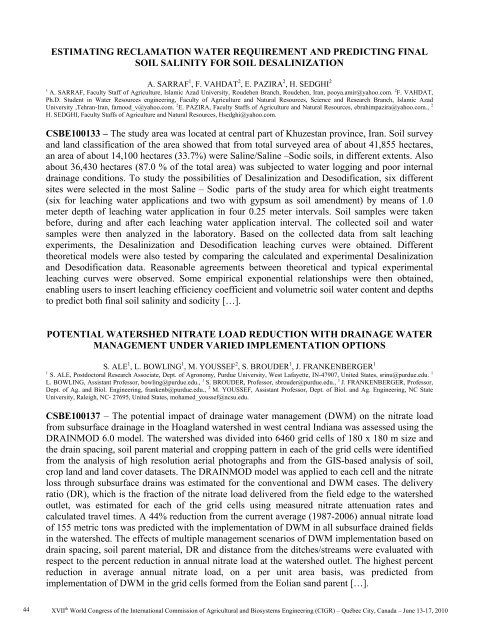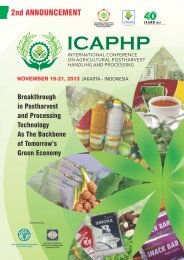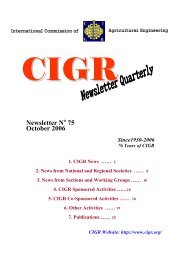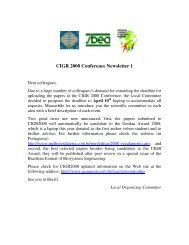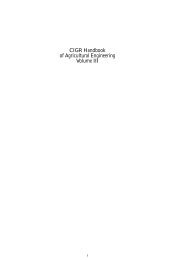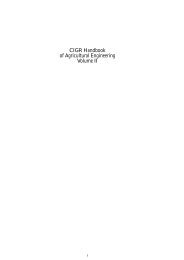CIGR2010-book-abstra..
CIGR2010-book-abstra..
CIGR2010-book-abstra..
Create successful ePaper yourself
Turn your PDF publications into a flip-book with our unique Google optimized e-Paper software.
ESTIMATING RECLAMATION WATER REQUIREMENT AND PREDICTING FINAL<br />
SOIL SALINITY FOR SOIL DESALINIZATION<br />
A. SARRAF 1 , F. VAHDAT 2 , E. PAZIRA 2 , H. SEDGHI 2<br />
1<br />
A. SARRAF, Faculty Staff of Agriculture, Islamic Azad University, Roudehen Branch, Roudehen, Iran, pooya.amir@yahoo.com. 2 F. VAHDAT,<br />
Ph.D. Student in Water Resources engineering, Faculty of Agriculture and Natural Resources, Science and Research Branch, Islamic Azad<br />
University ,Tehran-Iran, farnood_v@yahoo.com. 2 E. PAZIRA, Faculty Staffs of Agriculture and Natural Resources, ebrahimpazira@yahoo.com., 2<br />
H. SEDGHI, Faculty Staffs of Agriculture and Natural Resources, Hsedghi@yahoo.com.<br />
CSBE100133 – The study area was located at central part of Khuzestan province, Iran. Soil survey<br />
and land classification of the area showed that from total surveyed area of about 41,855 hectares,<br />
an area of about 14,100 hectares (33.7%) were Saline/Saline –Sodic soils, in different extents. Also<br />
about 36,430 hectares (87.0 % of the total area) was subjected to water logging and poor internal<br />
drainage conditions. To study the possibilities of Desalinization and Desodification, six different<br />
sites were selected in the most Saline – Sodic parts of the study area for which eight treatments<br />
(six for leaching water applications and two with gypsum as soil amendment) by means of 1.0<br />
meter depth of leaching water application in four 0.25 meter intervals. Soil samples were taken<br />
before, during and after each leaching water application interval. The collected soil and water<br />
samples were then analyzed in the laboratory. Based on the collected data from salt leaching<br />
experiments, the Desalinization and Desodification leaching curves were obtained. Different<br />
theoretical models were also tested by comparing the calculated and experimental Desalinization<br />
and Desodification data. Reasonable agreements between theoretical and typical experimental<br />
leaching curves were observed. Some empirical exponential relationships were then obtained,<br />
enabling users to insert leaching efficiency coefficient and volumetric soil water content and depths<br />
to predict both final soil salinity and sodicity […].<br />
POTENTIAL WATERSHED NITRATE LOAD REDUCTION WITH DRAINAGE WATER<br />
MANAGEMENT UNDER VARIED IMPLEMENTATION OPTIONS<br />
S. ALE 1 , L. BOWLING 1 , M. YOUSSEF 2 , S. BROUDER 1 , J. FRANKENBERGER 1<br />
1 S. ALE, Postdoctoral Research Associate, Dept. of Agronomy, Purdue University, West Lafayette, IN-47907, United States, srinu@purdue.edu. 1<br />
L. BOWLING, Assistant Professor, bowling@purdue.edu., 1 S. BROUDER, Professor, sbrouder@purdue.edu., 1 J. FRANKENBERGER, Professor,<br />
Dept. of Ag. and Biol. Engineering, frankenb@purdue.edu., 2 M. YOUSSEF, Assistant Professor, Dept. of Biol. and Ag. Engineering, NC State<br />
University, Raleigh, NC- 27695, United States, mohamed_youssef@ncsu.edu.<br />
CSBE100137 – The potential impact of drainage water management (DWM) on the nitrate load<br />
from subsurface drainage in the Hoagland watershed in west central Indiana was assessed using the<br />
DRAINMOD 6.0 model. The watershed was divided into 6460 grid cells of 180 x 180 m size and<br />
the drain spacing, soil parent material and cropping pattern in each of the grid cells were identified<br />
from the analysis of high resolution aerial photographs and from the GIS-based analysis of soil,<br />
crop land and land cover datasets. The DRAINMOD model was applied to each cell and the nitrate<br />
loss through subsurface drains was estimated for the conventional and DWM cases. The delivery<br />
ratio (DR), which is the fraction of the nitrate load delivered from the field edge to the watershed<br />
outlet, was estimated for each of the grid cells using measured nitrate attenuation rates and<br />
calculated travel times. A 44% reduction from the current average (1987-2006) annual nitrate load<br />
of 155 metric tons was predicted with the implementation of DWM in all subsurface drained fields<br />
in the watershed. The effects of multiple management scenarios of DWM implementation based on<br />
drain spacing, soil parent material, DR and distance from the ditches/streams were evaluated with<br />
respect to the percent reduction in annual nitrate load at the watershed outlet. The highest percent<br />
reduction in average annual nitrate load, on a per unit area basis, was predicted from<br />
implementation of DWM in the grid cells formed from the Eolian sand parent […].<br />
44<br />
XVII th World Congress of the International Commission of Agricultural and Biosystems Engineering (CIGR) – Québec City, Canada – June 13-17, 2010


